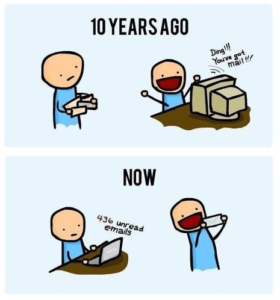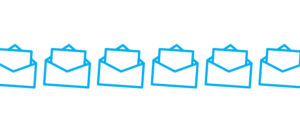Although email can be a useful means of communication, it has also been described as "a toxic source of stress". Due to technology enabling people to be at their email’s constant beck and call, psychologists have warned that a culture can develop where people can feel they are constantly available for work. This negatively impacts on emotional well-being.
You don't have to look far for tips on how to to personally mitigate this by, for example, scheduling emails in bulk rather than leaving your browser open all day, blocking or filtering unwanted emails (not including those from your Equality & Diversity team, of course!), picking up the phone!
Useful as these tips are, we know that solutions need to address matters further upstream rather than focusing exclusively how individuals themselves should better manage the mountain of messages that might accumulate in any given day. To that end, we may want to become more conscious of how and why email is being used, and the culture we as a department foster regarding the role of email in our work.
As a starting point, the E&D committee and Executive Committee have developed some guidance notes on email etiquette that we would encourage staff to follow. We hope that these are useful in setting the tone for our expectations around email use and minimises the potential of your inbox becoming that toxic source of stress, which makes you feel "on" 24/7.
1. Automatic-replies during annual leave and when away from the office (e.g. attending conferences)
To find a balance between becoming a prisoner to emails and still effectively processing the massive number of emails we receive during periods when you are away from the office, creating a generic acknowledgement for email exchanges might be helpful. For example:
‘Thank you for your email. I am currently out of the office and will not return until xxx. During this period, I will have no access (or limited access) to my email.
If you require immediate assistance in my absence, please contact xxx on xxx@xxx.
Otherwise, I will respond to your email as soon as possible on my return.
Best wishes,
.....’
By adding something like the above message as an out of office reply, the email recipients will know your return date and who to contact in your absence, so that you do not feel under pressure to check email and respond while you are away.
2. Only discuss public matters
Please be cautious about the matter and issues you are discussing via university emails. This is important due not only to potential issues with data protection, but also as there is a possibility that private matters, or conflict issues that should be confidential, are inadvertently passed around to the entire Department, University, or even over the internet.
3. Using subject lines more productively
Start your email subject line with some keywords so that the recipient knows immediately what the email is about, for example, Action requested, Two minute action please, for info/FYI, Question, Invitation, Important.
4. Keep emails short, simple, and tell the readers what to do
Emails can get stuck in our inboxes because it is not immediately clear how to easily deal with the message. Please keep your email simple and focused on a single topic message. A quick tip would be to start your emails with an action verb; for example, Confirm, Approve, Agree/Disagree, Thank, Get in touch, Circulate, etc. Also, include enough information in the body of the email to reduce the number of back-and-forth messages (e.g., provide available dates for a meeting up front).
5. Weekends/Evenings
We recognise that flexibility in work patterns can be beneficial in many instances. However, we are equally mindful that email traffic during evenings and weekends can contribute to an ‘always-on’ culture, which we do not endorse. We kindly advise all members of staff wishing to send emails outside of working hours, to inform the recipient that a response is not expected nor required during these times. For ease, some staff may prefer to insert a generic message into their email signature. For example:
“I work a flexible working pattern so may send emails out of 'normal' working hours. Please be assured that I do not expect a response outside of your own working hours.”
6. Refrain from sending one-liners
Messages like ‘Thanks’, or 'OK’ do not advance the conversation. Please feel free to put ‘No Reply Necessary’ at the top of the email or in the subject line when you don’t anticipate a response.
7. TO
Please address the person directly, or a group of people that are relevant to the email.
8. CC
The main purposes of CC are to increase clarity, transparency and authority, but not to embarrass, expose or promote an individual agenda.
- Please copy others only on a need to know basis.
- Avoid CC’ing more people than those that really need to know.
- Avoid CC’ing people who you are expecting actions or responses from (better to address them directly in the ‘To’ column).
9. BCC
Avoid devious use of the BCC button, and be aware that if the person BCC’d clicks ‘reply all’, then everyone else will know you have BCC’d them! However, this is useful as a tool to protect the privacy of those on your lists when sending group emails.
10. Reply All
Do not Reply All unless every member on the email chain needs to know. It’s acceptable to Reply All when there is a definitive answer to a question that can benefit everyone (e.g. confirming a date).
Please use Reply All cautiously, as you don’t want to congest people’s email boxes.
11. Screening information (in box, sent box and deleted emails)
Do not keep anything that you do not need, as this reduces the need to expand email memory capacity, and also reduces the amount of emails you have to sift through if you receive any subject access requests.
12. Other ways of communication
Consider when alternatives to email would be quicker/more efficient (e.g., face-to-face, phone call).
There are several productivity theories/models available online that focus on processing emails rather than checking your inbox. For example, this diagram created by Graham Allcott provides a great decision-making guide to help with you do this.
These guidance notes will be uploaded onto the Department wiki page and also included into the induction pack for all new staff.
We welcome constructive feedback on what we're trying to achieve here. Please do contact Cassie (c.phoenix@bath.ac.uk) with any comments, or if you prefer to remain anonymous these can come through Yvonne Ascott (y.s.ascott@bath.ac.uk).
Respond

